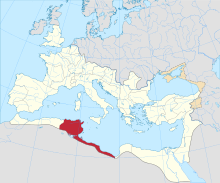
Utimmira was an ancient Roman town of the Roman province of Africa Proconsularis. The town was somewhere near Carthage in today's Tunisia, but the exact location has been lost to history.
Utimmira was the seat of an ancient episcopal see, suffragan of Archdiocese of Carthage.[1][2] Only two bishops attributed to this diocese: the Catholic Severus, who intervened at the Council of Carthage (411)[3] and Bishop Reparatus, who took part in the Council of Carthage (484) called by the Vandal king Huneric, after which Reparatus was exiled to Corsica. Today Utimmira survives as titular bishop,[4][5] the current bishop is Edouard Isango Nkoyo, of Republic Democratic of Congo.

References[edit]
- ^ Pius Bonifacius Gams, Series Episcoporum Ecclesiae Catholicae, (Leipzig, 1931), p. 470.
- ^ Stefano Antonio Morcelli, Africa Christiana, Volume I, (Brescia, 1816), p. 364 .
- ^ At that time the Utimmira had no Donatist bishops.
- ^ "Utimmara". www.catholic-hierarchy.org.
- ^ "Utimmira". www.gcatholic.org.
Well, that’s interesting to know that Psilotum nudum are known as whisk ferns. Psilotum nudum is the commoner species of the two. While the P. flaccidum is a rare species and is found in the tropical islands. Both the species are usually epiphytic in habit and grow upon tree ferns. These species may also be terrestrial and grow in humus or in the crevices of the rocks.
View the detailed Guide of Psilotum nudum: Detailed Study Of Psilotum Nudum (Whisk Fern), Classification, Anatomy, Reproduction